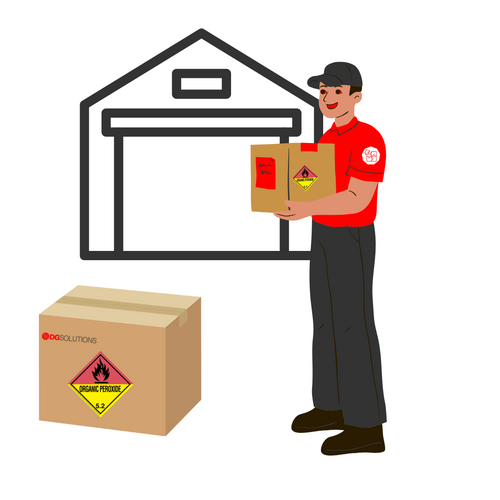
What Are Class 5.2 Dangerous Goods?
Class 5.2 dangerous goods are defined by the UN (United Nations) system of classification as organic peroxides. These compounds contain a peroxide group (–O–O–), a bond between two oxygen atoms, which is inherently unstable. The instability of the oxygen-oxygen bond makes organic peroxides highly reactive, and they can decompose violently, especially when exposed to heat, shock, or other environmental factors.
Organic peroxides are used in various industries, from polymer production to pharmaceuticals, but their reactive nature means that they need to be handled with extreme care. In the Globally Harmonised System (GHS) of classification and labelling of chemicals, organic peroxides are recognised as a distinct hazard class due to their explosive potential and the wide range of health risks they pose.
Key Characteristics of Class 5.2 Dangerous Goods
Class 5.2 includes chemicals that have the following characteristics:
Instability and Reactivity: Organic peroxides are highly reactive compounds that can decompose, releasing oxygen and heat, which can lead to a fire or explosion if not carefully controlled.
Wide Range of Applications: Despite their hazards, organic peroxides are valuable in a variety of industrial processes, such as polymerisation, curing agents for plastics, and even in the production of pharmaceuticals.
Hazardous Decomposition Products: When decomposing, organic peroxides can release toxic gases, including oxygen and other potentially harmful chemicals, making their management particularly critical in confined spaces.
Types of Organic Peroxides
Organic peroxides can be divided into several categories based on their chemical structure and stability. Some common examples include:
Benzoyl Peroxide: Used widely in the polymerisation of plastics and resins.
Methyl Ethyl Ketone Peroxide (MEKP): Common in the manufacturing of composite materials and in curing resins.
Hydrogen Peroxide: While often used as a disinfectant, it can be classified as a dangerous good in concentrated forms.
Each type of organic peroxide varies in its sensitivity to heat, light, and other reactive conditions, requiring specific safety measures during storage and transport.
Safety Measures for Handling Class 5.2 Dangerous Goods
Because of the high risks associated with organic peroxides, strict safety protocols are essential in industries dealing with Class 5.2 materials. Here are some important safety guidelines:
1. Proper Storage
Organic peroxides must be stored in cool, dry, and well-ventilated areas. Many require refrigeration to maintain stability, and temperature extremes should be avoided. The containers must be tightly sealed and clearly labelled to indicate their hazardous nature.
2. Minimise Exposure to Heat and Shock
Because heat, friction, or shock can trigger the decomposition of organic peroxides, care should be taken to prevent such exposures. Always store organic peroxides away from ignition sources, sparks, and incompatible chemicals.
3. Personal Protective Equipment (PPE)
When working with Class 5.2 dangerous goods, appropriate PPE is vital. This includes chemical-resistant gloves, safety goggles, and lab coats. In some situations, face shields and respirators may also be required, especially in cases of large-scale handling or accidental spills.
4. Training and Emergency Preparedness
Workers should be thoroughly trained on the properties, risks, and safety measures associated with organic peroxides. This includes knowing how to handle spills, leaks, or accidents and having emergency response plans in place, such as firefighting measures and first-aid protocols.
5. Transportation and Handling Regulations
Class 5.2 dangerous goods must comply with local and international transportation regulations, including the ADR (European Agreement concerning the International Carriage of Dangerous Goods by Road), IMDG (International Maritime Dangerous Goods), and IATA (International Air Transport Association) standards. These regulations dictate the correct packaging, labelling, and shipping conditions necessary to safely transport organic peroxides.
Class 5.2 dangerous goods, consisting of organic peroxides, are a diverse and essential group of chemicals used across many industries. However, their highly reactive nature makes them a significant safety concern. Proper storage, handling, and transportation procedures are critical to minimising risks associated with their use.
By understanding the potential hazards and following strict safety guidelines, industries can harness the benefits of organic peroxides while keeping workers, the public, and the environment safe from harm. Whether in manufacturing, research, or transportation, safety is always the priority when dealing with Class 5.2 dangerous goods.
